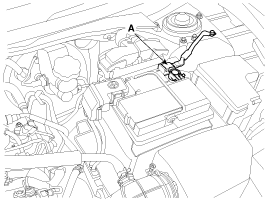 Hyundai Veloster: Battery Sensor
Hyundai Veloster 2011-2017 Service Manual / Engine Electrical System / Charging System / Battery Sensor
Hyundai Veloster: Battery Sensor
Hyundai Veloster 2011-2017 Service Manual / Engine Electrical System / Charging System / Battery Sensor
Hyundai Veloster 2011-2017 Service Manual / Engine Electrical System / Charging System / Battery Sensor
Description and Operation
Description
Vehicles have many control units that use more electricity. These units
control their own system based on information from diverse sensors. It is important
to have a stable power supply as there diverse sensors giving a variety of information.
Battery sensor (A) is mounted on battery (-) terminal. It transmits battery
voltage, current, temperature information to ECM. ECM controls generating voltage
by duty cycle based on these signals.

When battery sensor signal fault occurs, inspect the vehicle parasitic
draw in advance after inspecting the sensor because the sensor will
behave abnormally when the parasitic draw is more than 100mA. (Refer
to vehicle parasitic current inspection)
|
It takes a few hours for a new battery sensor to detect the battery
state correctly.
Perform the following process after replacing the battery sensor.
|
For the vehicle equipped with a battery sensor, be careful not
to damage the battery sensor when the battery is replaced or recharged.
|
 Repair procedures
Repair procedures
Removal and Installation
1.
Remove the battery.
(1)
Disconnect the battery terminals (A).
Tightening ...
 Starting System
Starting System
...
See also:
Tilting the sunroof
Before opening or closing the sunroof, open the sunshade.
To open the sunroof, push the sunroof control lever upward.
To close the sunroof, push the sunroof control lever forward until the sunroof ...
Crankshaft Position Sensor (CKPS). Description and Operation
Description
Crankshaft Position Sensor (CKPS) detects the crankshaft position and
is one of the most important sensors of the engine control system. If there
is no CKPS signal input, the eng ...
Special Service Tools
Special Service Tools
Tool (Number and Name)
Illustration
Use
Deployment tool
0957A-34100A
Airbag deployment tool.
...
Categories
- Hyundai Veloster Manuals Home
- Hyundai Veloster 2010-2017 Owner's Manual
- Hyundai Veloster 2010-2017 Service Manual
© 2011-2025 Copyright www.hvmanual.com
